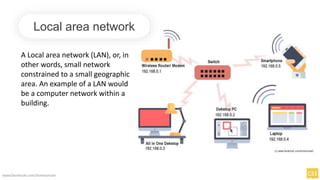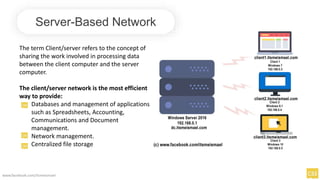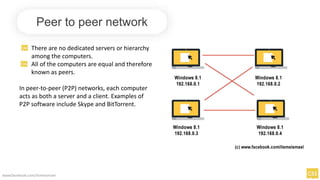Basic-Concepts-in-Computer-Networks.pptx
- 1. DepEd ETUlay DepEd ETUlay
- 2. DepEd ETUlay DepEd ETUlay Computer System Servicing G11 Q3 Week 1 : Basic Concepts of Networking
- 4. Quarter 3 Week 1 LO 1 Install network cables Code: TLE_IACSS9-12SUCN-Iva-j-33 At the end of our tutorial, you are expected to; • Understands the basic concepts in computer network technology • Identify the different types of network
- 5. INTRODUCTION A computer network is a group of computer that shares information or data that linked together in the same communication medium. www.facebook.com/itsmeismael
- 6. Local area network A Local area network (LAN), or, in other words, small network constrained to a small geographic area. An example of a LAN would be a computer network within a building. www.facebook.com/itsmeismael
- 7. Personal area network A Personal Area Network (PAN) is a computer network used for communication among computer devices, including smartphone and tablet, in proximity to an individual's body. www.facebook.com/itsmeismael
- 8. Wide area network A wide area network (WAN) is a computer network that covers a broad area (i.e., any network whose communications links cross metropolitan, regional, or national boundaries). The largest WAN in existence is the Internet. www.facebook.com/itsmeismael
- 9. Metropolitan area network A metropolitan area network (MAN) is a hybrid between a LAN and a WAN. Like a WAN, it connects two or more LANs in the same geographic area. www.facebook.com/itsmeismael
- 10. Storage area network A storage area network (SAN) is a dedicated storage network that provides access to consolidated, block level storage. SANs are used primarily to make storage devices (such as disk arrays) accessible to servers so that the devices appear as locally attached to the operating system. www.facebook.com/itsmeismael
- 11. The Internet It is a network of networks that consists of millions of interconnected devices, that are linked by a broad array of electronic, wireless and optical networking technologies. www.facebook.com/itsmeismael
- 12. Virtual Private Network A VPN is a private network that is constructed within a public network infrastructure such as the global Internet. a telecommuter can access the network of the company headquarters through the Internet by building a secure tunnel between the telecommuter’s PC and a VPN router in the headquarters. It is a mechanism for providing secure, reliable transport over Internet. VPNs are frequently used by remote workers or companies with remote offices to share private data and network resources. www.facebook.com/itsmeismael
- 13. Server-Based Network The term Client/server refers to the concept of sharing the work involved in processing data between the client computer and the server computer. The client/server network is the most efficient way to provide: Databases and management of applications such as Spreadsheets, Accounting, Communications and Document management. Network management. Centralized file storage www.facebook.com/itsmeismael
- 14. Peer to peer network There are no dedicated servers or hierarchy among the computers. All of the computers are equal and therefore known as peers. In peer-to-peer (P2P) networks, each computer acts as both a server and a client. Examples of P2P software include Skype and BitTorrent. www.facebook.com/itsmeismael
- 15. QUIZ TIME
- 16. The largest WAN in existence is the Internet. A. TRUE B. FALSE
- 17. In peer-to-peer (P2P) networks, each computer acts as both a server and a client. A. TRUE B. FALSE
- 18. Local area network (LAN), or, in other words, small network constrained to a small geographic area. A. TRUE B. FALSE
- 21. DepEd ETUlay DepEd ETUlay THANK YOU! Up Next : Tutor Lon Computer System Servicing G12





















